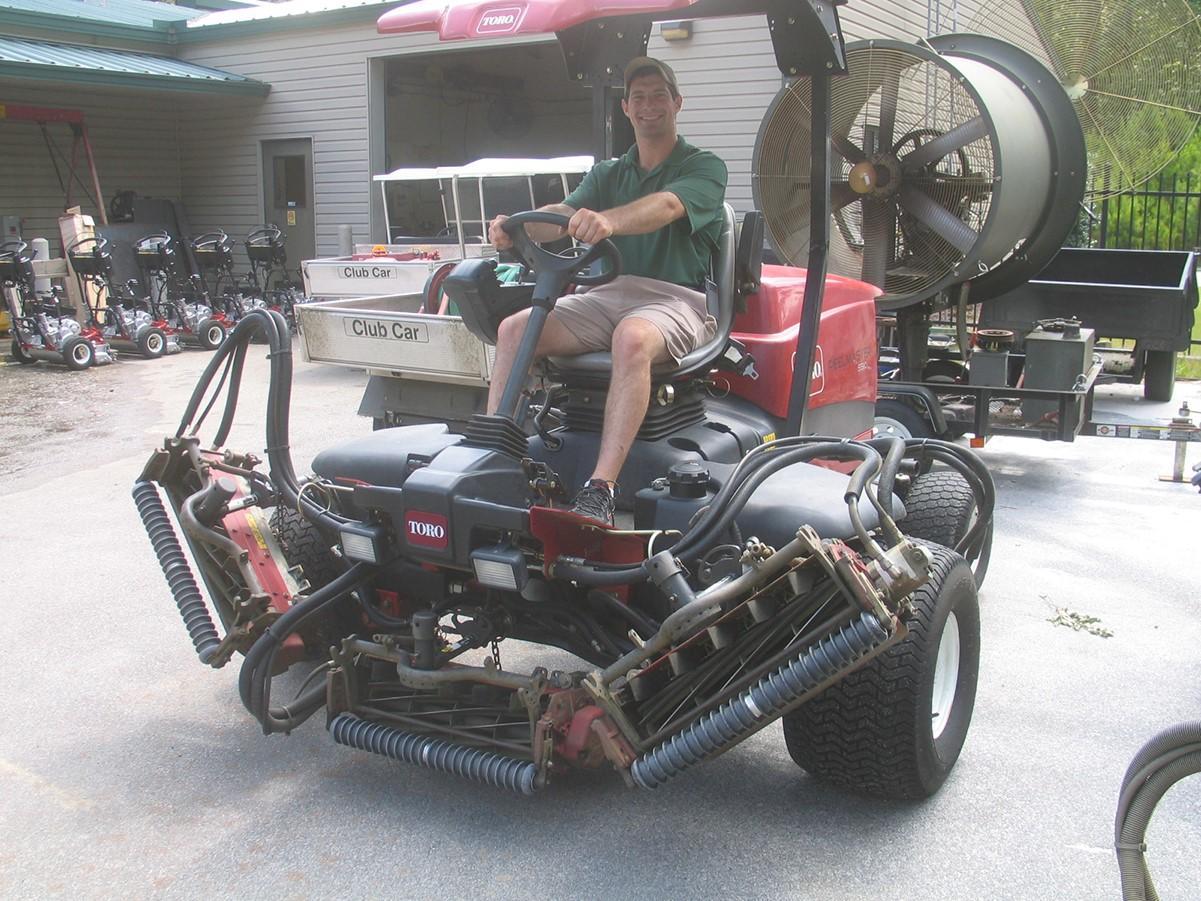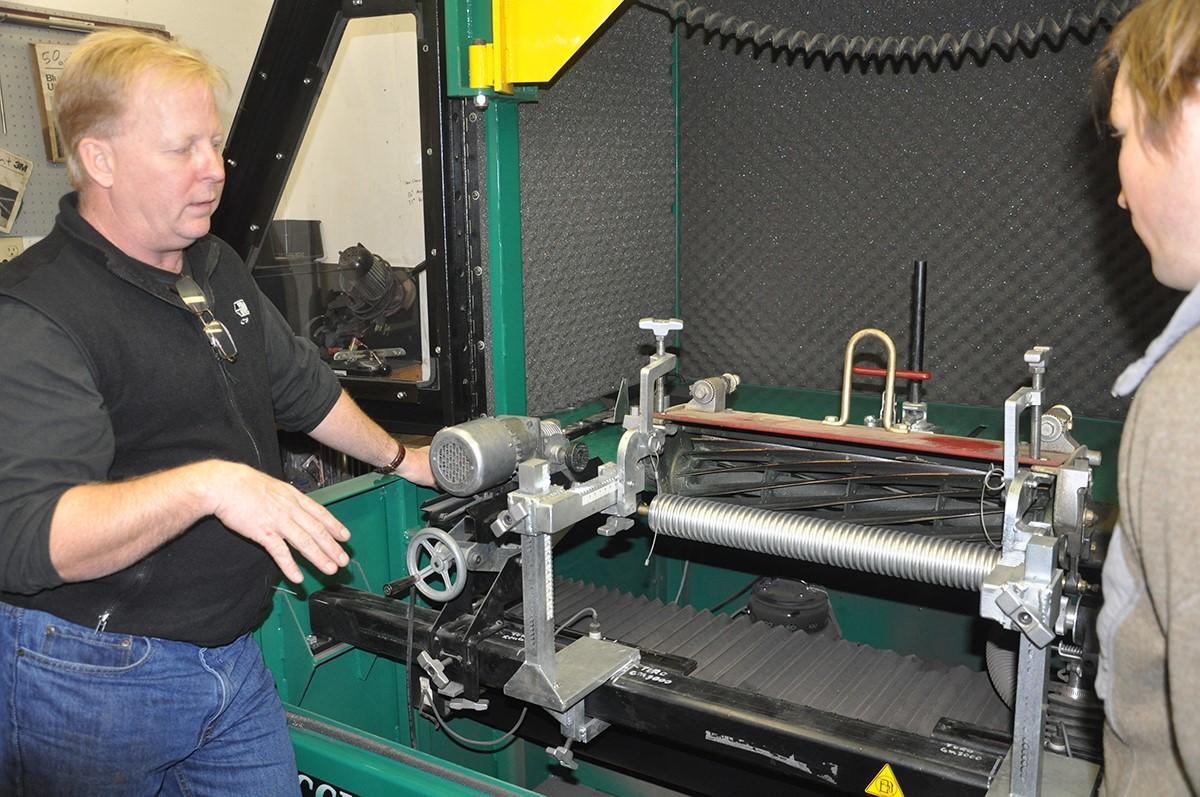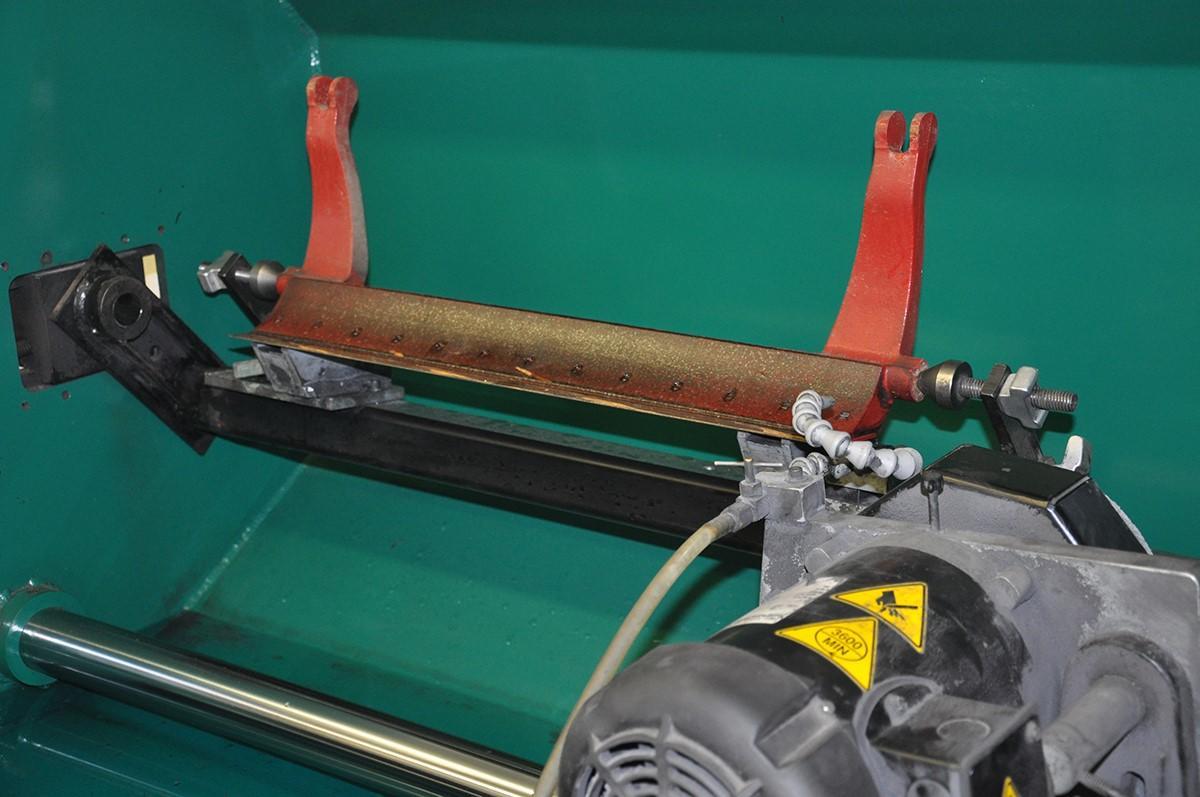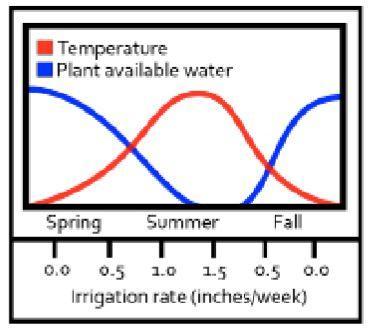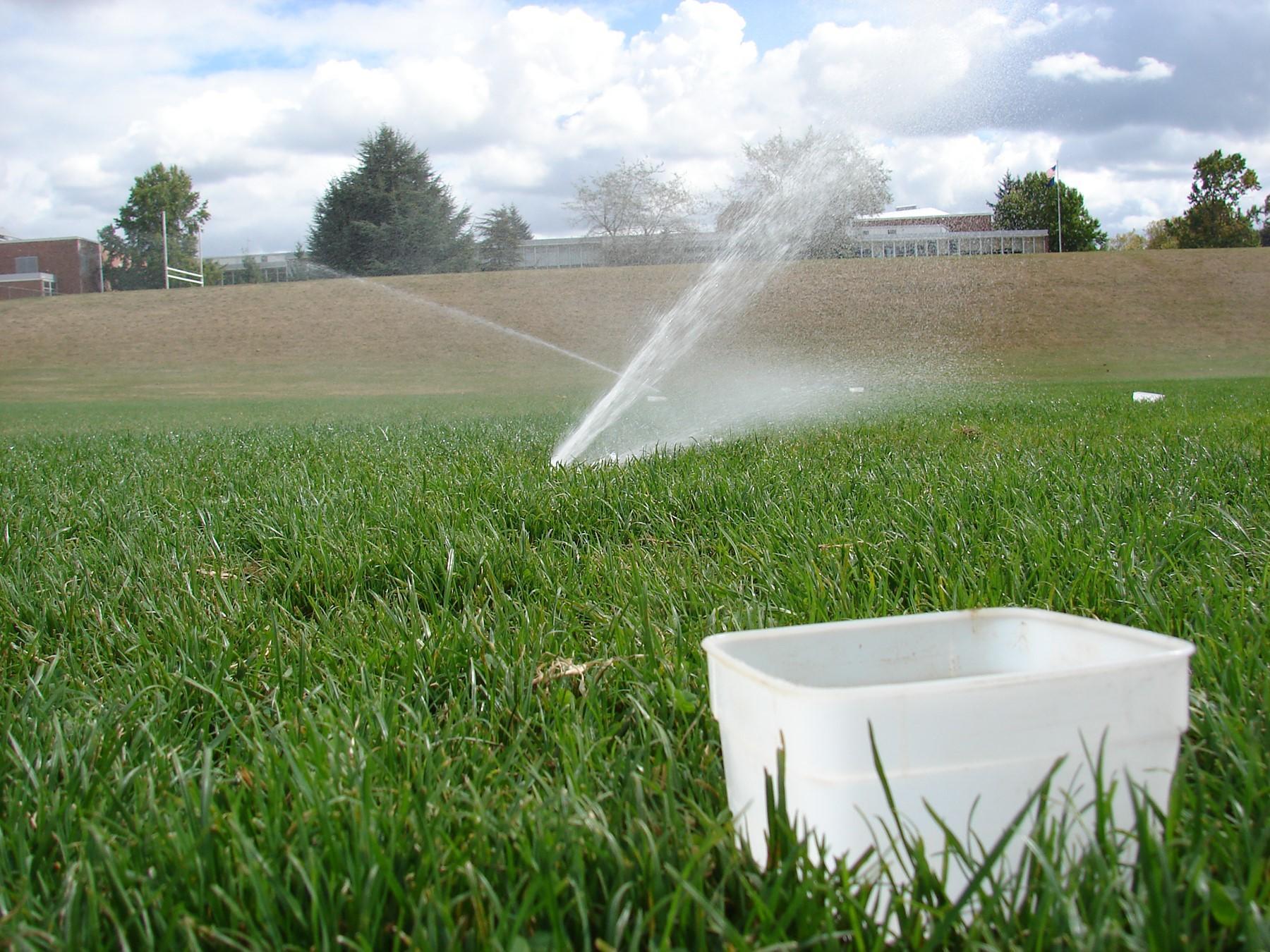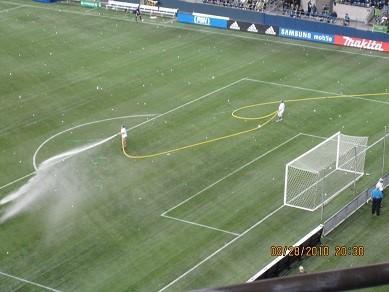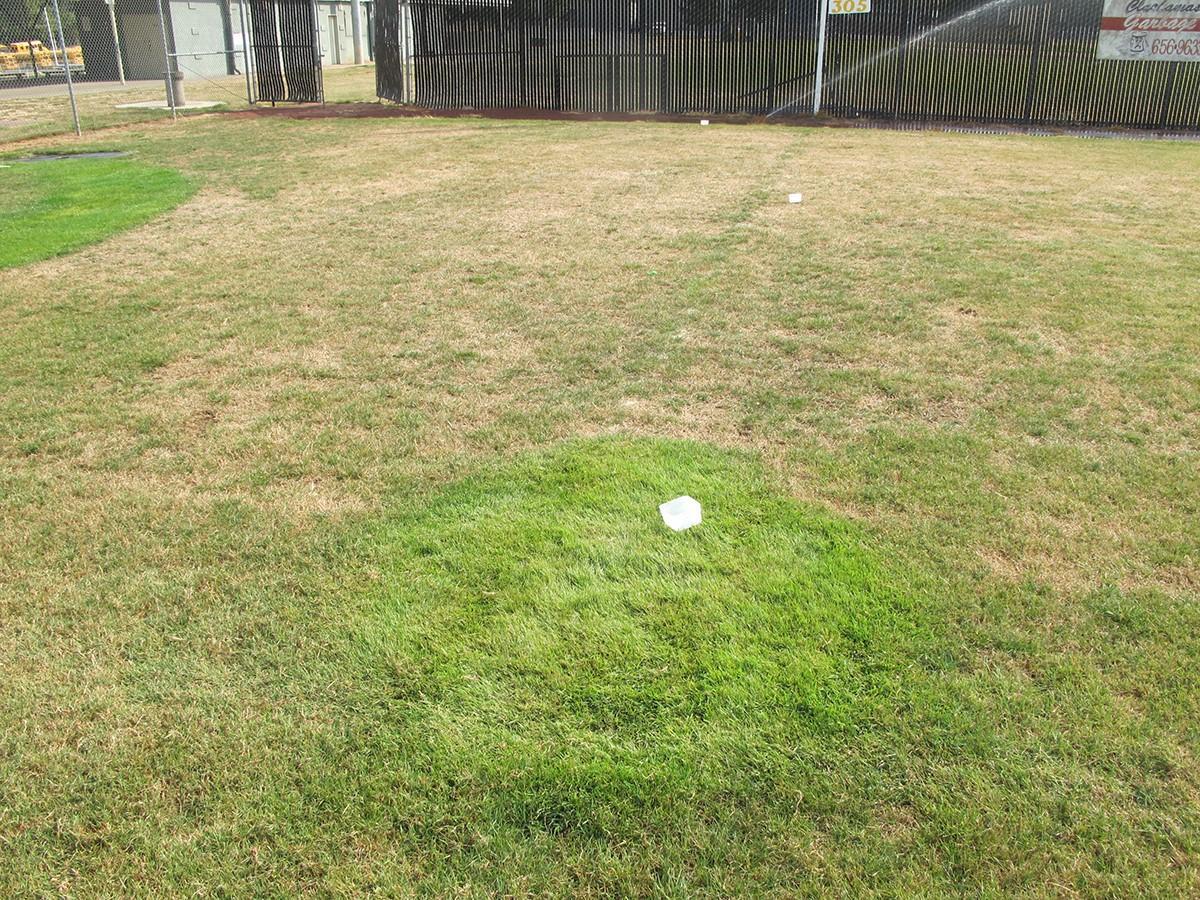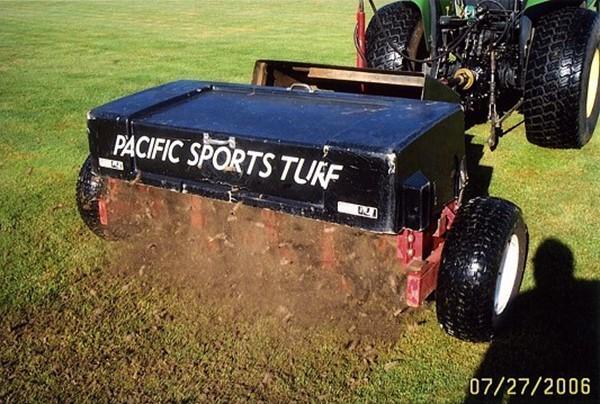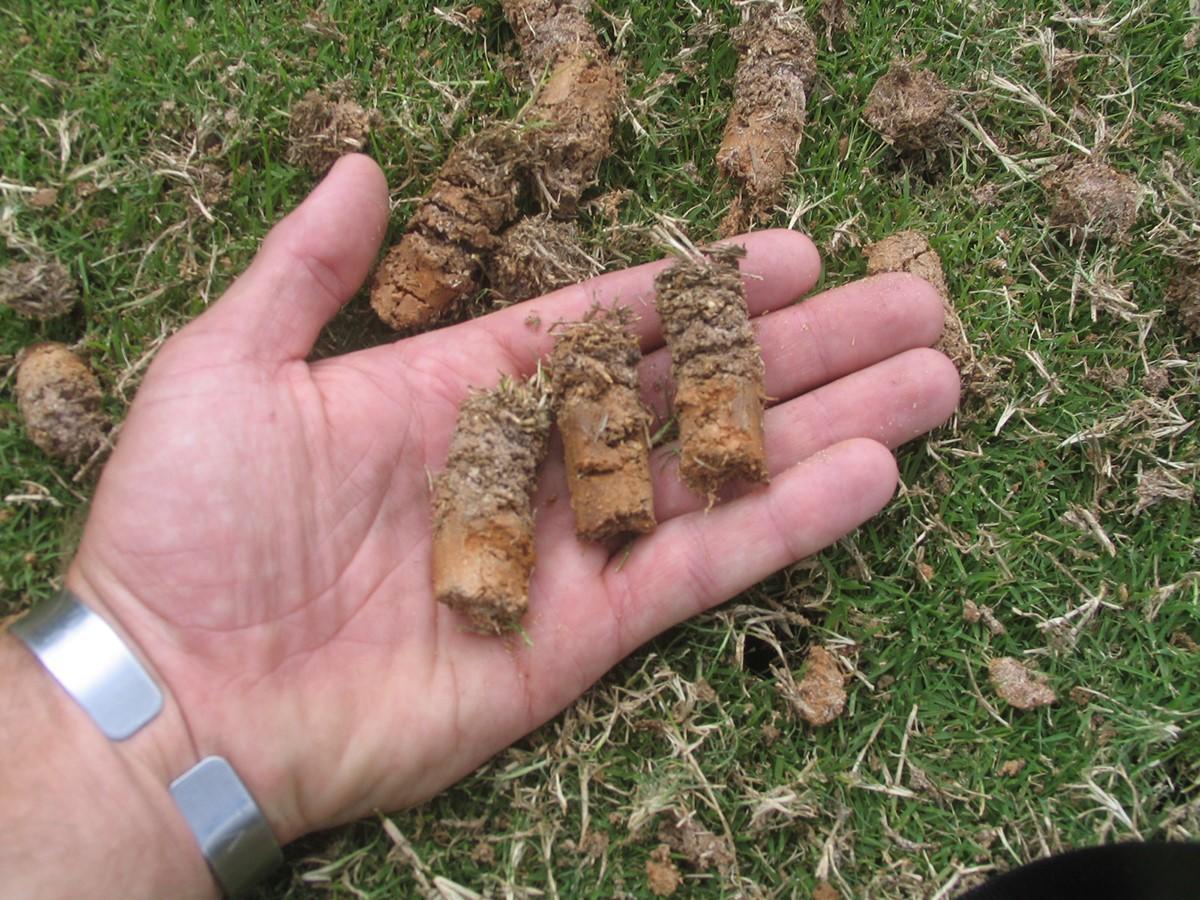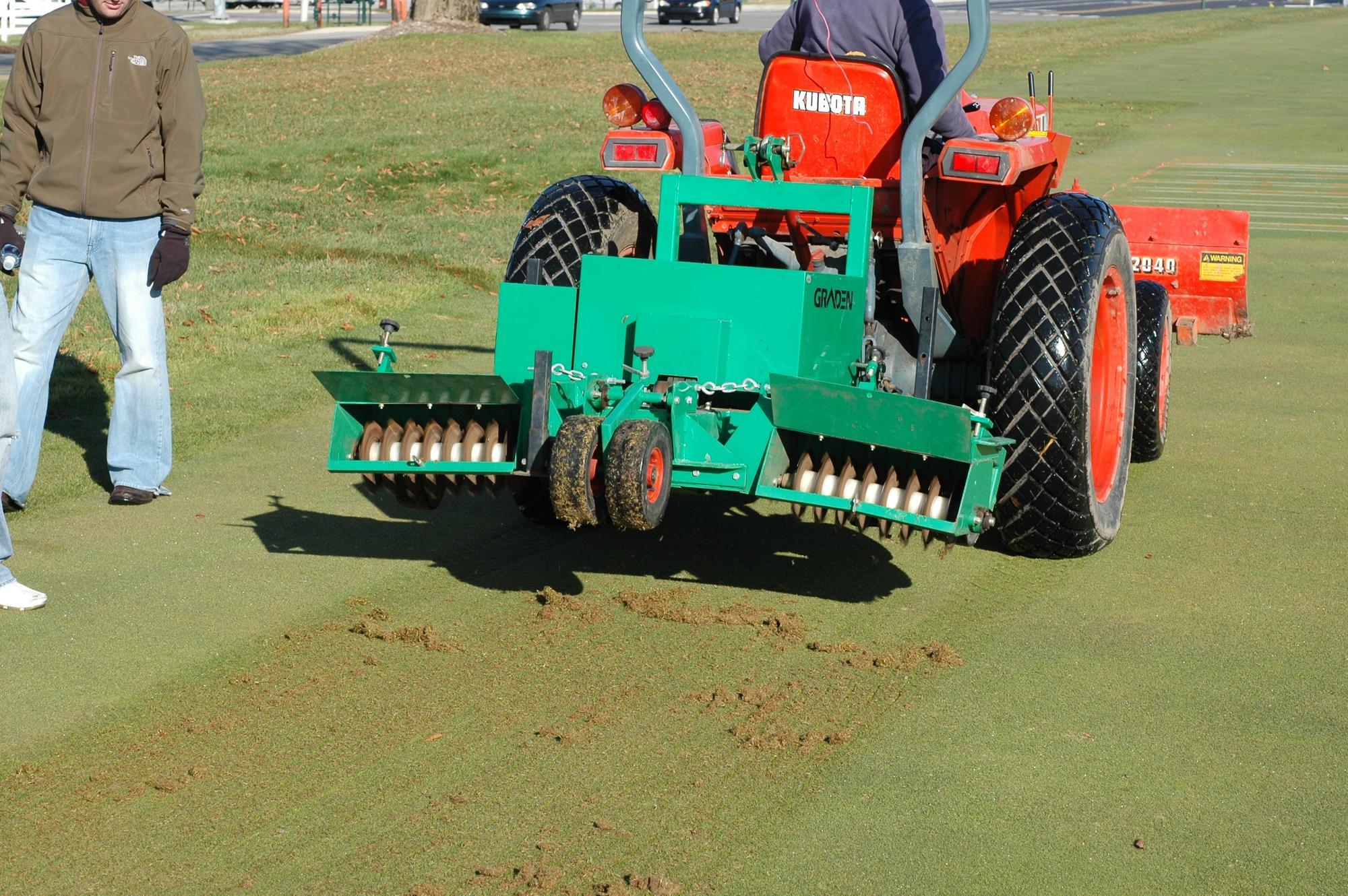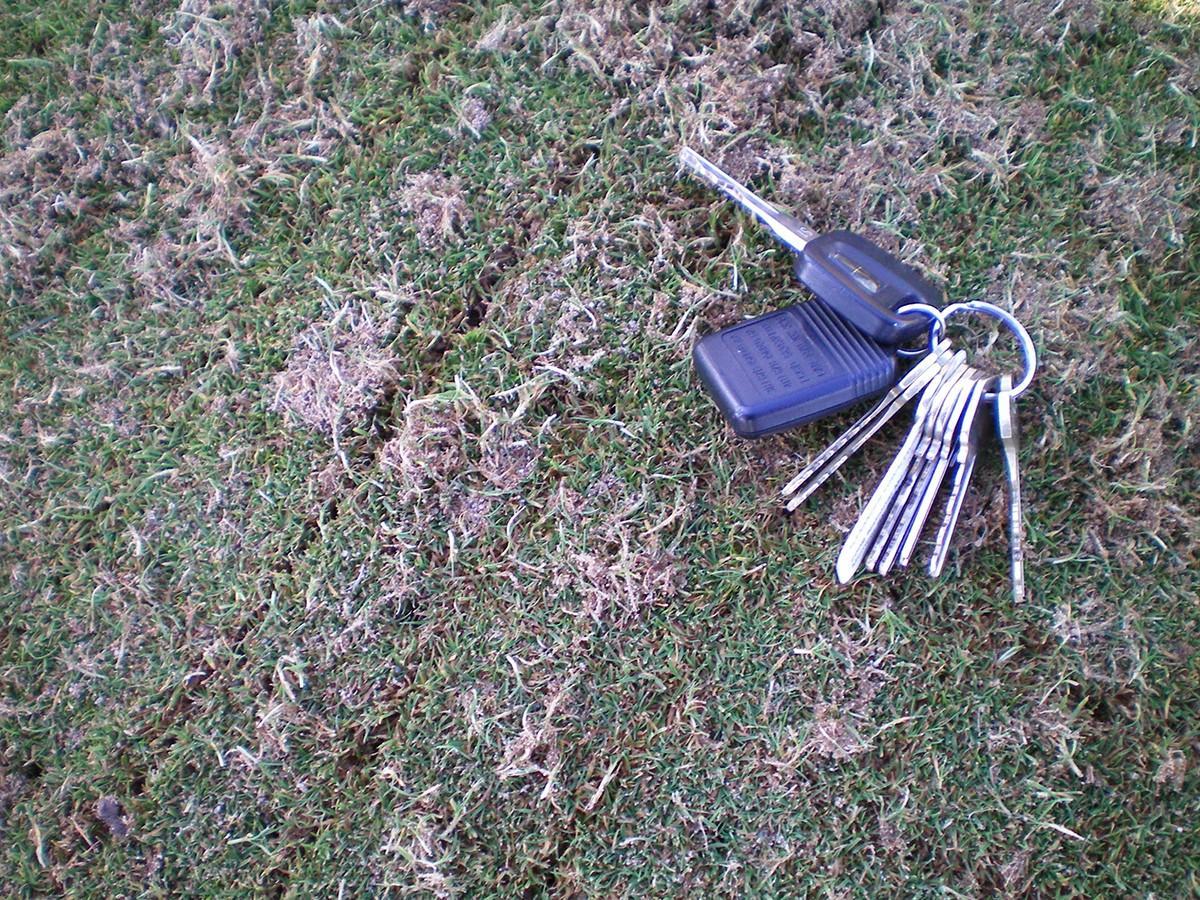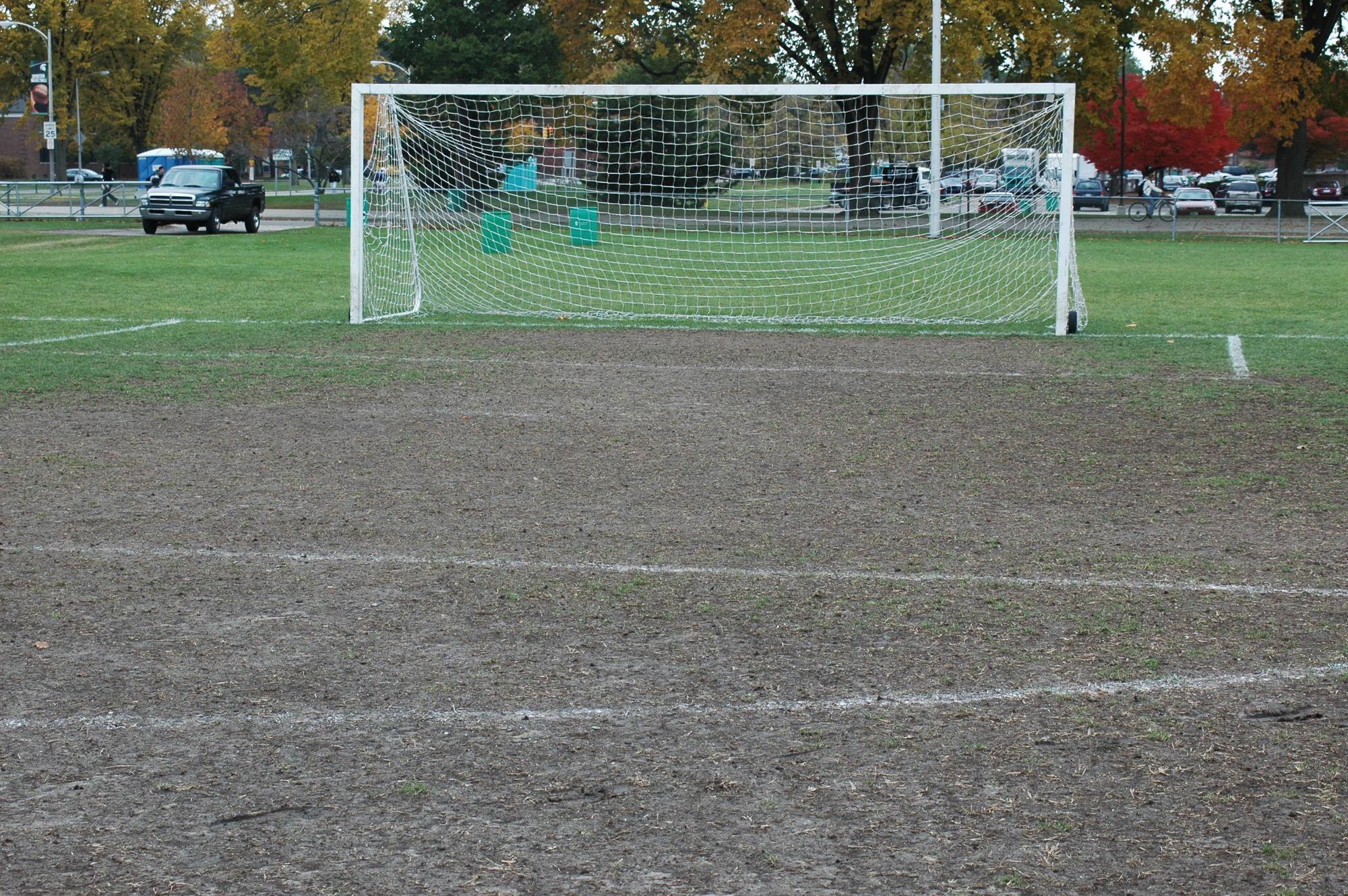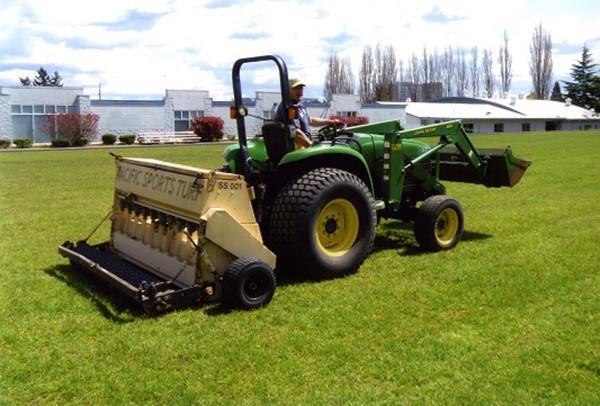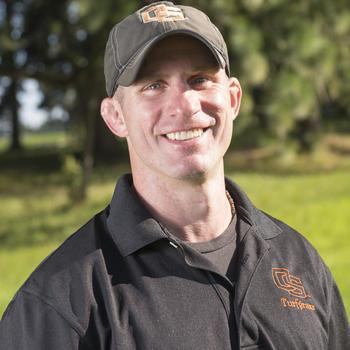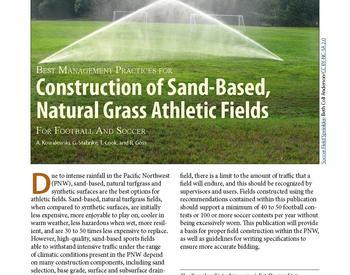The following recommendations are specific to the management of sand-based fields, which require more frequent fertilization, irrigation and cultivation for proper maintenance than native soil fields. This publication emphasizes the critical aspects of maintenance, including the primary cultural practices (mowing, fertilization, and irrigation), as well as the secondary cultural practices (cultivation, top-dressing, and interseeding). See Tables 1 and 2 for approximate timing, depending on weather and location, of the primary and secondary cultural practices in the Pacific Northwest.
This publication is available as a PDF and as an eBook (see supplemental file below). After downloading and using an OSU Extension eBook, please send us your feedback.
| Jan | Feb | Mar | Apr | May | Jun | Jul | Aug | Sep | Oct | Nov | Dec | |
|---|---|---|---|---|---|---|---|---|---|---|---|---|
| Mowing | • | •• | •••• | •••• | ••• | ••• | ••• | •••• | •••• | ••• | • | |
| Fertilizing | • | • | • | • | • | • | • | |||||
| Irrigation | •• | •••• | •••• | •••• | •• | |||||||
| Cultivation | • | • | • | • | • | |||||||
| Top-dressing | • | • | • | • | • | |||||||
| Interseeding | • | • | • | • | • | • | • |
• Intensity per month for the various primary (mowing, fertilization and irrigation) and secondary (cultivation, top-dressing and interseeding) cultural practices.
| Jan | Feb | Mar | Apr | May | Jun | Jul | Aug | Sep | Oct | Nov | Dec | |
|---|---|---|---|---|---|---|---|---|---|---|---|---|
| Mowing | • | •••• | •••• | •••• | •••• | •••• | •••• | ••• | • | |||
| Fertilizing | • | • | • | • | • | |||||||
| Irrigation | •••• | •••• | •••• | •••• | •••• | ••• | ||||||
| Cultivation | • | • | • | • | ||||||||
| Top-dressing | • | • | • | • | ||||||||
| Interseeding | • | • | • | • | • |
The primary cultural practices: mowing, fertilization and irrigation
Regardless of the quality of playing surface you are managing, there are three primary cultural practices essential to sustaining a healthy and vigorous natural grass athletic field — mowing, fertilization and irrigation. More time and money should be spent on the primary cultural practices than the secondary cultural practices (cultivation, top-dressing, interseeding, etc.). If limited by time or money or both, remove the secondary practices, always trying to maintain good primary cultural practices.
Mowing
The best mowing height for a field is influenced by many factors. Most new fields east of the Cascade Mountains are established with Kentucky bluegrass (Poa pratensis), while fields west of the mountains are dominated by perennial ryegrass (Lolium perenne) (Table 3).
With the development of improved turf-type tall fescues (Festuca arundinacea), more athletic fields and other municipal turf areas in the high-desert climate are dominated by this grass species. While the older cultivars of tall fescue couldn’t be maintained at a mowing height as low as perennial ryegrass and Kentucky bluegrass, the newest, partially rhizomatous tall fescues can be maintained very well at athletic field heights. Tall fescue is planted in combination with lower-water-using Kentucky bluegrass in other regions because it requires less fertility and irrigation.
| Common name | Scientific name | Suitable environments | Mowing height |
|---|---|---|---|
| Spreading ryegrass | Lolium perenne | West of the Cascades | 0.75-2” |
| Perennial ryegrass | Lolium perenne | West of the Cascades | 1-2” |
| Kentucky bluegrass | Poa pratensis | East of the Cascades | 1.5-2.5” |
| Turf-type tall fescue | Festuca arundinacea | East of the Cascades | 2-3” |
West of the Cascade Mountains, spreading ryegrass has grown in popularity. This turf can be mowed at a height lower than the grasses previously mentioned, and with its lateral growth, it recovers from traffic better than traditional perennial ryegrass, which is a bunch-type turfgrass. While shorter mowing will provide a denser turf and a faster playing surface, it will also have a somewhat shallower root system, increasing the fertilization and irrigation frequency necessary to maintain the turf in the summer months.
Turf with a lower mowing height will also be more susceptible to weed encroachment, particularly annual bluegrass (Poa annua) encroachment (Figure 1). A higher mowing height will increase the rooting depth, making the field more resistant to drought stress between irrigation events, but will decrease turf density and the speed of the surface.
The two dominant types of mowers available for turfgrass management are rotary and reel (Figure 2). Both of these mowers have their strengths and weaknesses. For instance, a rotary mower is durable, fast and the blades are relatively easy and cheap to service. However, rotary mowers typically should not be used on turfgrass maintained at a mowing height less than 1 inch.
Reel mowers on the other hand provide a superior cut when turf is maintained at 1 inch or lower and stripe the grass very well. However, reel mowers typically can’t be used on turf maintained at heights of 2 inches or greater. Reel mowers’ blades and bed knives are more expensive to sharpen and require more frequent sharpening (Figure 3).
Frequent mowing is also an important practice when trying to maintain an aesthetically pleasing and traffic-tolerant turfgrass stand.
Mowing a field weekly during the summer at the proper height will ensure that the turf has maximum density and uniformity during the fall sports season. One of the worst mistakes people make with athletic fields is mowing sporadically, or not at all, for a good portion of the summer. This will decrease turf density, and when the turf is mowed, excessive foliage will be removed. This drains carbohydrate reserves and often results in root dieback. In addition, the heavy accumulation of clippings from infrequent mowing may smother the turf. If clippings are removed, scalping will open the turf and provide the opportunity for weed seed germination.
In most cases, mowing weekly during the summer is adequate. However, during periods of peak growth (spring and fall) and heavy use, mowing twice a week is preferred. Regular mowing at the proper height is the best way to ensure a quality athletic field year-round. In addition, regular mowing will allow clippings to be left on the field and mitigate nutrient imbalances that may occur on sand fields when clippings are removed.
Fertilization
Sand-based athletic fields, unlike native soil fields high in silt and clay, will require more frequent fertilization with the primary nutrients nitrogen (N), potassium (K) and phosphorus (P). Regular soil testing will help identify secondary and micronutrient deficiencies and pH imbalances as they develop over time.
The primary nutrients: nitrogen, phosphorus and potassium
The most important nutrient in a fertility program is nitrogen (N). This element has the greatest influence on color and vegetative growth, including leaf, tiller, and root growth and development. The typical turfgrass plant has an N tissue content of about 4 percent. Typical N recommendations range from 4 to 8 pounds N per 1,000 square feet annually. Tall fescue will require N levels at the low end of this range (4 to 6 pounds N per 1,000 square feet annually), while perennial ryegrass and Kentucky bluegrass will require N rates at the high end of the range (6 to 8 pounds N per 1,000 square feet annually).
The nutrient with the second-highest concentration in turfgrass is potassium (K), which will be about 2 percent of the tissue weight. Benefits of adequate K levels include increased tolerance to extreme temperatures (heat and cold), and enhanced drought and wear tolerance.
The final primary nutrient is phosphorous (P), which is about 0.5 percent of the turfgrass tissue. Phosphorus will enhance root growth only when soil nutrient levels are deficient, 10 to 20 parts per million. Therefore, this nutrient should have the lowest concentration, in comparison to N and K, within a fertility program. In efforts to mitigate eutrophication (P-accelerated algae blooms and subsequent anaerobic conditions of a waterway), Washington state law prohibits the application of P to turfgrass unless a soil test documents a P deficiency (Washington State Legislature, 2015). Considering this regulation, if soil testing is done every two to four years, fertilizers without phosphorus can be used to provide a high-performance athletic field. In deficient conditions, supplementary phosphorus applications can be made with products like superphosphate (0 percent N/20 percent P/0 percent K) or triple superphosphate (0-45-0) at the rates suggested on the soil test.
When selecting a fertilizer, look for a complete fertilizer containing high amounts of nitrogen, low levels of phosphorus (or no P, in the state of Washington), and moderate concentrations of K. Complete fertilizers contain all three primary nutrients. In instances when regular soil testing is done, select a fertilizer containing N and K and no P, and then apply P when test results identify an approaching deficiency. After you have identified products with the proper concentrations of N, P, and K, take a closer look at the fertilizer analysis and be sure to select products containing equal proportions of quick- and slow-release nitrogen sources (Table 4 and Figure 4).
Table 4. When reviewing fertilizer bags, look for products containing equal proportions of quick- and slow-release nitrogen sources.
Quick-release nitrogen sources
• Urea
• Ammonium nitrate
• Calcium nitrate
• Ammoniacal nitrogen
Slow-release nitrogen sources
• Methylene urea
• Urea formaldehyde
• Sulfur-coated urea (SCU)
• Polymer-coated urea (PCU)
• Organics (Milorganite)
When developing a fertilizer plan for your athletic field, consider the typical growth cycle of cool-season turf throughout the year (Figure 5). In the mild winter climates of the Puget Sound region, Willamette Valley, and coastal areas of both Washington and Oregon, turf growth patterns are less pronounced. Spring is marked by a gradual increase in growth rate, which continues into summer except during very hot, dry periods. As fall approaches, vertical growth may slow, but tillering and density will increase, with the majority of the rhizomatous growth of Kentucky bluegrass occurring in the fall months. As winter and the rainy season arrive, growth will slow and density may decrease, but turf rarely goes dormant. Again, a complete fertilizer or N/K product applied in the spring and fall months will serve this environment well (Table 5).
During periods of heavy use in the spring or fall, light (0.5 pound N per 1,000 square feet), supplemental applications of quick-release nitrogen products such as urea (46-0-0) or ammonium nitrate (33-0-0), will provide much-needed tiller growth, helping the turf repair. Do not apply quick-release N products at rates greater than 0.5 pounds N per 1,000 square feet per application. Quick-release products have a high potential for fertilizer burn or phytotoxicity at high application rates, and at higher rates the quick release or water soluble N that is not used by the plant will be leached through the sand-based system.
In hot or cold climates east of the Cascade Mountains, i.e., eastern Washington and Oregon, and the state of Idaho, turf is dormant in winter, starts growth with a flush in mid- to late spring, tapers off during summer and picks up again in the fall before cold temperatures slow growth and eventually induce winter dormancy. In this cycle, tillering occurs in both the spring and fall, and a period of major root growth occurs in the spring. Considering this growth cycle, turfgrass should be fertilized in the spring and fall months using a complete fertilizer or N/K fertilizer (Table 6). Again, during periods of heavy traffic, supplemental application of quick-release N products will promote some much-needed growth and repair.
| Athletic season | Turfgrass | Apr | May | Jun | Aug | Sept | Oct | Nov |
|---|---|---|---|---|---|---|---|---|
| Spring | Tall fescue | • ♦ | • ♦ | • | • | |||
| Perennial ryegrass or Kentucky bluegrass | • ♦ | • ♦ | • ♦ | • | • | • | ||
| Fall | Tall fescue | • | • | • ♦ | • ♦ | |||
| Perennial ryegrass or Kentucky bluegrass | • | • | • | • | • ♦ | • ♦ | ♦ | |
| Spring and fall | Tall fescue | • ♦ | • ♦ | • | • ♦ | |||
| Perennial ryegrass or Kentucky bluegrass | • | • ♦ | • ♦ | • | • | • ♦ | ♦ |
• Complete fertilizer or N/K product (sample ratios: 24-4-8 or 24-0-8, respectively, the latter of which must be used in the state of Washington) applied at 1 pound N per 1,000 square feet; annual rates range from 4 to 6 pounds N per 1,000 square feet annually.
♦ Light applications (0.5 pound N per 1,000 square feet) of quick-release fertilizer [examples include urea (46-0-0) and ammonium nitrate (33-0-0)]. Supplemental applications of quick-release products range from 1 to 2 pounds N per 1,000 square feet annually.
Soil testing
Collect composite soil samples from sand-based fields annually and native soil fields every two to four years. The steps to a proper composite soil sample are as follows:
- Collect 10 to 20 samples to a 4-inch depth using a soil probe or hand trowel.
- Discard all grass and accumulated thatch material.
- Using a plastic bucket, mix the soil taken into one composite sample.
- After the soil has been thoroughly mixed, put a cup of it into a plastic bag or a soil mailing kit bag provided by the soil-testing laboratory.
- Mail the sample to the appropriate testing laboratory.
When submitting a composite soil sample to an analytical laboratory, several options are available (See EM 8677, Analytical Laboratories Serving Oregon). The two most common to turfgrass fertility are a basic soil analysis and a complete soil analysis. A basic soil analysis typically includes macronutrient levels (P and K), and secondary micronutrient levels of magnesium (Mg) and sulfur (S). This analysis comes with application recommendations necessary to remedy deficiencies, as well as soil pH and lime requirements. A complete soil analysis typically includes the analysis provided within the basic soil test as well as several micronutrient levels — such as iron (Fe), manganese (Mn), boron (B), copper (Cu) and zinc (Zn) — and application recommendations. Lime and micronutrients typically should not be applied unless an imbalance or deficiency has been noted by the soil test.
When choosing lime materials, it is important to keep in mind the properties of common products. Agricultural limestone is composed entirely of calcium carbonate (CaCO3), is generally finely ground, and is relatively soluble. If used repeatedly for liming, it could eventually lead to a deficiency in Mg. Dolomitic limestone, on the other hand, contains both CaCO3 and magnesium carbonate — CaMg(CO3)2 — is slower to react in soil than agricultural lime but is generally longer lasting than an equivalent amount of agricultural lime. Lime should be added to sand-based modified soils when soil pH drops to 5.5 or lower. If the calcium-to-magnesium ratio is greater than 7:1, dolomitic lime should be applied.
While the fertilizer guide section of a basic soil analysis will indicate the amount of lime required to raise the pH to the desired level, never apply more than 25 to 50 pounds of product per 1,000 square feet per application. Rates higher than this tend to form a layer at the surface and may result in localized nutrient tie up or high pH near the soil surface. Fall is a convenient time to apply lime materials and take advantage of the rain, which will incorporate the heavy lime application rates into the soil. After lime has been applied, continue sampling every two to four years.
| Athletic season | Turfgrass | April | June | August | September | October |
|---|---|---|---|---|---|---|
| Spring | Tall fescue | • ♦ | • ♦ | • | • | |
| Perennial ryegrass or Kentucky bluegrass | • ♦ | • ♦ | • | • | • | |
| Fall | Tall fescue | • | • | • ♦ | • ♦ | |
| Perennial ryegrass or Kentucky bluegrass | • | • | • ♦ | • ♦ | • ♦ | |
| Spring and fall | Tall fescue | • | • ♦ | • | • ♦ | |
| Perennial ryegrass or Kentucky bluegrass | • ♦ | • ♦ | • | • ♦ | • ♦ |
• Light applications (0.5 pounds N per 1,000 square feet) of quick-release fertilizer [examples include urea (46-0-0) and ammonium nitrate (33-0-0)]; supplemental applications of quick-release products range from 1-2 pounds N per 1,000 square feet annually.
♦ Complete fertilizer or N/K product (sample ratios: 24-4-8 or 24-0-8, respectively, the latter of which must be used in the state of Washington) applied at 1 pound N per 1,000 square feet; annual rates range from 4 to 5 pounds N per 1,000 square feet annually.
Irrigation
Sand-based athletic fields will require frequent irrigation, particularly during the summer months, because of the inherently low water-holding capacity of sand and the environmental conditions present in the Pacific Northwest.
West of the Cascade Mountains, irrigation programs will fluctuate drastically from season to season (Figure 6). In the late fall, winter and early summer, little to no irrigation will be required. As temperature rises and precipitation diminishes, gradually add irrigation events, always applying around 0.25 inch per irrigation event.
For instance, in June and early July, applying three to four irrigation events per week at 0.25 inch would translate to 0.75 to 1.0 inch per week. At the peak of the summer — August and early September — five weekly events at 0.25 inch would provide 1.25 inches per week. Consider more frequent irrigation during periods of heat and drought stress. During these months, the roots of cool-season turf have a tendency to shorten, making deep irrigation cycles past the root zone a waste of water and money. Also, if drought stress between irrigation events persists, cool-season turf will enter summer dormancy, i.e., turn yellow and brown.
To optimize water use and prevent summer dormancy on sand-based athletic fields, increase the number of weekly irrigation events (maintaining around 0.25 inch per event) rather than increasing the depth per irrigation event. When maintaining native soil athletic fields, deeper (0.5 inches), less-frequent irrigation events will maintain adequate turfgrass.
East of the Cascade Mountains, irrigation demands increase drastically. Where annual precipitation is minimal, irrigation may need to be applied anywhere from 4 to 7 days a week, depending on soil type, temperatures, humidity and wind. Again, try to apply around 0.25 inch per irrigation application to sand-based fields and 0.5 inch per event to native soil systems. Add days to the irrigation program rather than increase irrigation depth. The potential for desiccation between irrigation events in the dry, windy, and low relative humidity climate of eastern Washington and Oregon and the state of Idaho is high, so frequent irrigation is required.
Irrigation systems range from hoses to aluminum sprinkler pipes to sophisticated underground units with time clocks (Figure 7). Regardless of the system, do an annual irrigation audit in the spring to determine if valves, heads or nozzles need replacement and how much time is required per zone or valve to apply 0.25 inch per irrigation event. Valves, heads and nozzles wear out over time and need to be replaced. Run times need to be periodically adjusted.
Plan irrigation events around playing events. Even though sand-based fields are designed to resist compaction, they are still subject to surface sealing due to organic debris or fine particle-sized soil that accumulates at the surface. These materials are more prone to being ground into the surface if they are wet than if they are dry. For that reason, it’s best to keep the field dry before games and to water if needed after major use. This is not an option for fields in constant use, but it’s a useful way to minimize surface sealing and soggy conditions on fields used only for games.
Even though sand is used in athletic fields to promote good drainage, it can become quite hydrophobic if allowed to completely dry out. The result is localized dry spots. Most localized dry spots are caused by malfunctioning sprinklers with insufficient overlap (Figure 8). They may develop in early summer before irrigation has started. Regardless of the cause, it is difficult to rewet dry spots without the aid of chemical wetting agents. Localized dry spots on sand-based fields with uniform irrigation distribution are often caused by excessive organic matter accumulation, which can be relieved by cultivation, core aerification or vertical mowing.
Cultivation
Core cultivation, or aerification, is one of the most important maintenance tools available to remove organic matter, relieve surface compaction, and improve gas exchange and water infiltration on athletic fields (Figure 9). On intensively used fields, aerification may be necessary four or more times per year. Critical periods for aerifying most fields are in early fall prior to fall sports, at the end of the fall- or winter-use season, in the spring prior to major growth, and in early summer after the spring sports season. A field aerified at these times will generally maintain high levels of infiltration throughout the year.
When selecting a core cultivation method, be sure to select a tool that removes organic matter and relieves compacted soil (Figure 10). Because the aerification process leaves soil cores strewn over the field, it may be desirable to drag the area with a steel mat followed by a mechanical sweeper, or to lightly vertical mow the area to break up cores. If aerification is necessary during the major-use season, solid tines or slicing attachments can be used to avoid the debris generated by the use of hollow tines.
Vertical mowing is done primarily to remove thatch and organic matter that has accumulated at the soil surface. However, this cultivation method will not relieve soil compaction to the depth of core cultivation (Figure 11).
Spring is generally an excellent time for thatch removal, since it precedes a period of favorable growth and allows ample recovery time during the summer. This process can also be coupled with core cultivation in the spring if athletic use is not scheduled. Depending on the field and the grasses, thatch may have to be removed every spring or every other spring.
Fields planted with Kentucky bluegrass, which has a vigorous rhizome system, tend to produce more thatch than fields planted with perennial ryegrass. Mixtures of these grasses will produce intermediate amounts of thatch. Vertical mowers for large areas generally have flail-type or solid blades, and both are quite effective in removing thatch. Please note that both units should be carefully adjusted to remove the thatch without destroying the turf.
Top-dressing
Top-dressing is a common practice when controlling thatch, as well as when firming and smoothing the playing surface. Top-dressing can be done in combination with core cultivation and vertical mowing or as a separate practice (Figure 12).
Typical athletic fields can easily tolerate 0.25 inch of material applied four or more times per year. Avoid heavy top-dressing applications; turf quality and surface stability will dramatically decline if application rate reaches or exceeds 0.5-inch depth per top-dressing.
In areas with wet winters or on native soil fields high in silt and clay, it is desirable to do as much top-dressing as possible during the dry months so that turf is healthy and dense by the time the rainy season arrives. While sand top-dressing applied to native soil fields will improve surface firmness and drainage, this process will also make the field more reliant on frequent fertilization and irrigation as the profile is changed from native soil to sand.
Interseeding (Overseeding)
As athletic fields lose density due to heavy traffic, they will need to be interseeded to build back turfgrass cover and prevent weed encroachment (Figure 13). High-traffic areas that are not interseeded have a tendency to transition back into areas dominated by annual weeds, such as annual bluegrass, crabgrass and knotweed. Under intense wear and changing environmental conditions (heat or cold) these annual weeds quickly die and the field will become thin turf or bare soil.
With a slice-seeding machine (Figure 14), desirable species can be seeded in thinning or bare areas whenever needed and as often as necessary to ensure good turf year-round. As traffic begins to thin a turfgrass stand, interseed as often as possible (weekly or after every sporting event).
Perennial ryegrass, because of its rapid, 7- to 10-day germination rate, is often the best interseeding option. In areas east of the Cascade Mountains, perennial ryegrass and then Kentucky bluegrass can be used during the season between athletic events and then after the season. In this climate, perennial ryegrass will provide a cover or nurse crop (giving the field a green appearance and preventing weed seed germination).
After the sports season is compete, seed Kentucky bluegrass, without perennial ryegrass, in the high desert of eastern Washington and Oregon, and the state of Idaho for a perennial stand of turf tolerant to the cold, dry winter. Seed perennial ryegrass (9 to 11 pounds of seed per 1,000 square feet) and Kentucky bluegrass (1.5 to 3 pounds of seed per 1,000 square feet). Do not couple pre-emergence herbicides with interseeding. The majority of pre-emergence herbicides are nonselective; applications of these products at this time will prevent the germination of both weeds and the seed being planted.
Athletic events are occurring later and earlier in the season each year. In areas of high wear, such as goal mouths or the center of the athletic field, turf-type, intermediate ryegrass has been used in combination with perennial ryegrass to get a quicker cover. The turf-type intermediate ryegrasses will germinate at 45° F and give cover two weeks earlier than the perennial ryegrasses alone. A suggested mix would be between 60 to 70 percent intermediate ryegrass, with 40 to 30 percent perennial ryegrass. This is a tool that has also been used in high-use areas on golf courses.
Summary
Mow your turfgrass at the recommended height once a week between use and twice a week during the athletic season.
- Make four to six fertilizer applications (depending on your turf and environment) at a rate of 1 pound N per 1,000 square feet using a complete fertilizer containing N, P, and K with a high ratio N, and low ratio of P (in the state of Washington use N/K products without P). Supplement the fertility program with light applications (0.5 pound N per 1,000 square feet) of quick-release nitrogen during the sports season.
- Apply 0.25 inch of irrigation per irrigation event starting with three or four irrigation events per week in the spring. Add irrigation events, while maintaining 0.25 inch per event, as heat and drought stress increase.
- Core cultivate in the spring and fall to relieve soil compaction, remove thatch, and improve drainage. Vertical mow in the spring to remove excess organic matter or thatch.
- Couple cultivation practices with sand top-dressing, or top-dress native soil fields, to firm and smooth the playing surface.
- Interseed with perennial ryegrass during periods of heavy traffic to rebuild the turf stand and prevent weed encroachment. After the season is complete, interseed with perennial ryegrass west of the Cascades Mountains and Kentucky bluegrass east of the mountains.
References
Hart, J. 2008. Analytical Laboratories Serving Oregon, Oregon State University Extension Service. EM 8677.
Washington State Legislature. 2015. RCW 15.54.500: “Turf fertilizer—Prohibitions on application, sales, and retail display.” Retrieved July 3, 2015. http://apps.leg.wa.gov/RCW/default.aspx?cite=15.54.500 and http://apps.leg.wa.gov/RCW/default.aspx?cite=15.54.500
Dedication
This publication is dedicated to Carl Kuhn, P.E., founder of Kuhn & Associates and a founding member of the Northwest Turfgrass Association who supported turfgrass research for many years. Carl and his two sons donated a lot of time to support turfgrass athletic field research projects over the years. We wish to acknowledge this support, as well as that of the Northwest Turfgrass Association and the Pacific Northwest Sport Turf Management Association.
Acknowledgments
Special thanks to Dr. W. J. Johnston, Washington State University, and T. McCammon, University of Idaho, for their helpful suggestions as manuscript reviewers.


